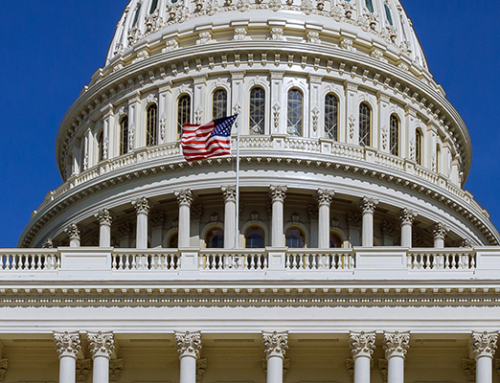On December 22, 2017 President Trump signed the Tax Cuts and Jobs Act (HR 1). The new act includes an employer credit for paid family leave. This provision was developed by Senator Deb Fischer (R-NE) to provide employers with a tax credit to encourage them to offer paid family leave. UWC provided some technical assistance in the development of this voluntary option for employers. This is viewed as one way to reduce the cost to employers of providing paid family leave and a better approach than a federal mandate that employers pay higher unemployment taxes as was initially proposed through increased solvency requirements in the President’s FY 2018 budget.
We continue to work with the Senator Fischer’s staff and Treasury on the implementation of this provision.
If you have questions that you would like to have forwarded about the definitions and implementation of this new law, please send them to Doug Holmes, holmesd@uwcstrategy.org.
Tax Cuts and Jobs Act
Employers that currently provide paid family leave and those considering adding paid family leave should take a close look at this new option that may provide a significant tax credit for 2018 and 2019.
Page 82 of the Act provides the legislative definitions and requirements:
SEC. 13403. EMPLOYER CREDIT FOR PAID FAMILY AND MEDICAL LEAVE.
(a) IN GENERAL.—
(1) ALLOWANCE OF CREDIT.—Subpart D of part IV of subchapter A of chapter 1 is amended by adding at the end the following new section:
‘‘SEC. 45S. EMPLOYER CREDIT FOR PAID FAMILY AND MEDICAL LEAVE.
‘‘(a) ESTABLISHMENT OF CREDIT.—
‘‘(1) IN GENERAL.—For purposes of section 38, in the case of an eligible employer, the paid family and medical leave credit is an amount equal to the applicable percentage of the
amount of wages paid to qualifying employees during any period in which such employees are on family and medical leave.
‘‘(2) APPLICABLE PERCENTAGE.—For purposes of paragraph (1), the term ‘applicable percentage’ means 12.5 percent increased (but not above 25 percent) by 0.25 percentage points
for each percentage point by which the rate of payment (as described under subsection (c)(1)(B)) exceeds 50 percent.
‘‘(b) LIMITATION.—
‘‘(1) IN GENERAL.—The credit allowed under subsection (a) with respect to any employee for any taxable year shall not exceed an amount equal to the product of the normal hourly
wage rate of such employee for each hour (or fraction thereof) of actual services performed for the employer and the number of hours (or fraction thereof) for which family and medical
leave is taken.
‘‘(2) NON-HOURLY WAGE RATE.—For purposes of paragraph (1), in the case of any employee who is not paid on an hourly wage rate, the wages of such employee shall be prorated to
an hourly wage rate under regulations established by the Secretary.
‘‘(3) MAXIMUM AMOUNT OF LEAVE SUBJECT TO CREDIT.— The amount of family and medical leave that may be taken into account with respect to any employee under subsection
(a) for any taxable year shall not exceed 12 weeks.
‘‘(c) ELIGIBLE EMPLOYER.—For purposes of this section—
‘‘(1) IN GENERAL.—The term ‘eligible employer’ means any employer who has in place a written policy that meets the following requirements:
‘‘(A) The policy provides—
‘‘(i) in the case of a qualifying employee who is not a part-time employee (as defined in section 4980E(d)(4)(B)), not less than 2 weeks of annual paid
family and medical leave, and
‘‘(ii) in the case of a qualifying employee who is a part-time employee, an amount of annual paid family and medical leave that is not less than an amount
which bears the same ratio to the amount of annual paid family and medical leave that is provided to a qualifying employee described in clause (i) as—
‘‘(I) the number of hours the employee is expected to work during any week, bears to ‘‘(II) the number of hours an equivalent qualifying employee described in clause (i) is expected
to work during the week.
‘‘(B) The policy requires that the rate of payment under the program is not less than 50 percent of the wages normally paid to such employee for services performed for the employer.
‘‘(2) SPECIAL RULE FOR CERTAIN EMPLOYERS.—
‘‘(A) IN GENERAL.—An added employer shall not be treated as an eligible employer unless such employer provides paid family and medical leave in compliance with
a written policy which ensures that the employer—
‘‘(i) will not interfere with, restrain, or deny the exercise of or the attempt to exercise, any right provided under the policy, and
‘‘(ii) will not discharge or in any other manner discriminate against any individual for opposing any practice prohibited by the policy.
‘‘(B) ADDED EMPLOYER; ADDED EMPLOYEE.—For purposes of this paragraph—
‘‘(i) ADDED EMPLOYEE.—The term ‘added employee’ means a qualifying employee who is not covered by title I of the Family and Medical Leave Act of 1993, as amended.
‘‘(ii) ADDED EMPLOYER.—The term ‘added employer’ means an eligible employer (determined without regard to this paragraph), whether or not covered by that
title I, who offers paid family and medical leave to added employees.
‘‘(3) AGGREGATION RULE.—All persons which are treated as a single employer under subsections (a) and (b) of section 52 shall be treated as a single taxpayer.
‘‘(4) TREATMENT OF BENEFITS MANDATED OR PAID FOR BY STATE OR LOCAL GOVERNMENTS.—For purposes of this section, any leave which is paid by a State or local government or
required by State or local law shall not be taken into account in determining the amount of paid family and medical leave provided by the employer.
‘‘(5) NO INFERENCE.—Nothing in this subsection shall be construed as subjecting an employer to any penalty, liability, or other consequence (other than ineligibility for the credit
allowed by reason of subsection (a) or recapturing the benefit of such credit) for failure to comply with the requirements of this subsection.
‘‘(d) QUALIFYING EMPLOYEES.—For purposes of this section, the term ‘qualifying employee’ means any employee (as defined in section 3(e) of the Fair Labor Standards Act of 1938, as amended)
who—
‘‘(1) has been employed by the employer for 1 year or more, and
‘‘(2) for the preceding year, had compensation not in excess of an amount equal to 60 percent of the amount applicable for such year under clause (i) of section 414(q)(1)(B).
‘‘(e) FAMILY AND MEDICAL LEAVE.—
‘‘(1) IN GENERAL.—Except as provided in paragraph (2), for purposes of this section, the term ‘family and medical leave’ means leave for any 1 or more of the purposes described under
subparagraph (A), (B), (C), (D), or (E) of paragraph (1), or paragraph (3), of section 102(a) of the Family and Medical Leave Act of 1993, as amended, whether the leave is provided
under that Act or by a policy of the employer.
‘‘(2) EXCLUSION.—If an employer provides paid leave as vacation leave, personal leave, or medical or sick leave (other than leave specifically for 1 or more of the purposes referred
to in paragraph (1)), that paid leave shall not be considered to be family and medical leave under paragraph (1).
‘‘(3) DEFINITIONS.—In this subsection, the terms ‘vacation leave’, ‘personal leave’, and ‘medical or sick leave’ mean those 3 types of leave, within the meaning of section 102(d)(2) of
that Act.
‘‘(f) DETERMINATIONS MADE BY SECRETARY OF TREASURY.—For purposes of this section, any determination as to whether an employer or an employee satisfies the applicable requirements for
an eligible employer (as described in subsection (c)) or qualifying employee (as described in subsection (d)), respectively, shall be made by the Secretary based on such information, to be provided
by the employer, as the Secretary determines to be necessary or appropriate.
‘‘(g) WAGES.—For purposes of this section, the term ‘wages’ has the meaning given such term by subsection (b) of section 3306 (determined without regard to any dollar limitation contained
in such section). Such term shall not include any amount taken into account for purposes of determining any other credit allowed under this subpart.
‘‘(h) ELECTION TO HAVE CREDIT NOT APPLY.—
‘‘(1) IN GENERAL.—A taxpayer may elect to have this section not apply for any taxable year.
‘‘(2) OTHER RULES.—Rules similar to the rules of paragraphs (2) and (3) of section 51(j) shall apply for purposes of this subsection.
‘‘(i) TERMINATION.—This section shall not apply to wages paid in taxable years beginning after December 31, 2019.’’.
(b) CREDIT PART OF GENERAL BUSINESS CREDIT.—Section 38(b) is amended by striking ‘‘plus’’ at the end of paragraph (35), by striking the period at the end of paragraph (36) and inserting
‘‘, plus’’, and by adding at the end the following new paragraph:
‘‘(37) in the case of an eligible employer (as defined in section 45S(c)), the paid family and medical leave credit determined under section 45S(a).’’.
(c) CREDIT ALLOWED AGAINST AMT.—Subparagraph (B) of section 38(c)(4) is amended by redesignating clauses (ix) through (xi) as clauses (x) through (xii), respectively, and by inserting after
clause (viii) the following new clause:
‘‘(ix) the credit determined under section 45S,’’.
(d) CONFORMING AMENDMENTS.—
(1) DENIAL OF DOUBLE BENEFIT.—Section 280C(a) is amended by inserting ‘‘45S(a),’’ after ‘‘45P(a),’’.
(2) ELECTION TO HAVE CREDIT NOT APPLY.—Section 6501(m) is amended by inserting ‘‘45S(h),’’ after ‘‘45H(g),’’.
H. R. 1—85
(3) CLERICAL AMENDMENT.—The table of sections for subpart D of part IV of subchapter A of chapter 1 is amended by adding at the end the following new item:
‘‘Sec. 45S. Employer credit for paid family and medical leave.’’.
(e) EFFECTIVE DATE.—The amendments made by this section shall apply to wages paid in taxable years beginning after December 31, 2017.






